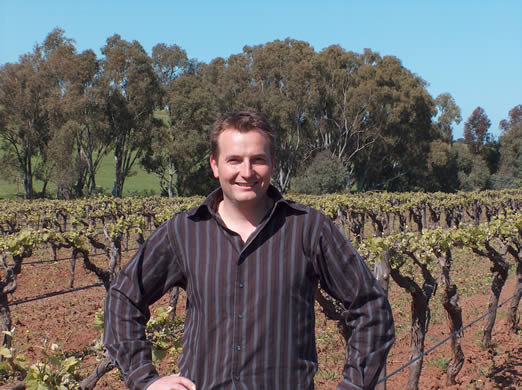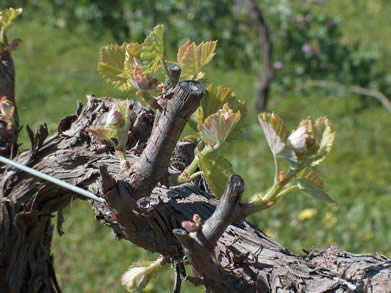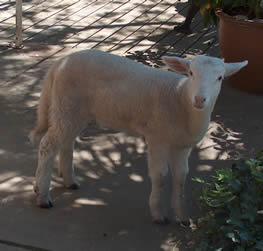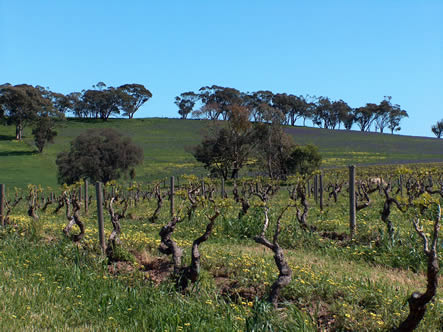|
The
New Barossa
Part 15:
Troy Kalleske

Considering that his is one of the hottest names in the
Barossa at the moment, Troy Kalleske is a quiet, unassuming sort of
guy. His family are long-time growers, and have been farming their
property since 1853. Troy is sixth generation (his ancestors were from Prussia, now part of Poland), and in the last 150
years the Kalleske farm has grown from 60 acres to its current 500.
120 acres are devoted to vines, while the balance  grows mainly wheat and hay. Troy worked for Southcorp
for three years, then in 2003 did vintage in Sonoma, California (with Kendall Jackson) and back in
the Barossa did vintage with Miranda. He made the first wines under
his own label in 2002, and then escalated quantities in both 2003
and 2004. grows mainly wheat and hay. Troy worked for Southcorp
for three years, then in 2003 did vintage in Sonoma, California (with Kendall Jackson) and back in
the Barossa did vintage with Miranda. He made the first wines under
his own label in 2002, and then escalated quantities in both 2003
and 2004.
We’re in Greenock here, which is east of the heart of
the Barossa. It’s at 350 metres, which is higher than most of the
region, and there are cooling breezes which also help to moderate
temperature during the growing season.
 The visit starts of quite comically (for me at least -
farming types are probably used to this sort of thing). As I get out
of the car I am greeted by two enthusiastic dogs (nothing unusual in
that) plus a sheep. This orphaned sheep was hand-reared along with
the dogs and as a result it thinks that it’s a dog. So the sheep
comes bounding up, but when I reach out to pat it on the head it
suddenly remembers it’s a sheep and becomes a bit more timid. The visit starts of quite comically (for me at least -
farming types are probably used to this sort of thing). As I get out
of the car I am greeted by two enthusiastic dogs (nothing unusual in
that) plus a sheep. This orphaned sheep was hand-reared along with
the dogs and as a result it thinks that it’s a dog. So the sheep
comes bounding up, but when I reach out to pat it on the head it
suddenly remembers it’s a sheep and becomes a bit more timid.
Troy is certified organic, but he doesn’t want to use
this information on the label – it’s not for marketing reasons,
it’s because he wants balanced, living soils. He grows Shiraz and
Grenache, with a bit of Cabernet and a smidgeon of Chenin. The
oldest vines date back to 1875.
 Wines
are made in open fermenters (of 1.5, 3 and 8 ton capacity). The
wines are fermented warm to hot (Grenache is the hottest), they are
left on skins for 1 or two weeks and then basket pressed. 6000 cases
are currently made, with a bit more again of contract wine making. Wines
are made in open fermenters (of 1.5, 3 and 8 ton capacity). The
wines are fermented warm to hot (Grenache is the hottest), they are
left on skins for 1 or two weeks and then basket pressed. 6000 cases
are currently made, with a bit more again of contract wine making.
Kalleske Clarry’s Barossa White 2005
A blend of Semillon (70%) and Chenin Blanc (30%). Lovely tight
bright fruity nose leads to a palate that is fresh and crisp with a
lovely expressive character. Troy incorporates some juice solids
during ferment and leaves it on its lees for a while. Retail A$15.
Very good+ 88/100
Kalleske Clarry’s Barossa Red 2004
80% Grenache and 20% Shiraz, spending 12 months in older
barrels. Lovely ripe, slightly sweet black fruits nose, with a
chocolatey spicy edge and a hint of tarry lift. The palate is broad,
rich, ripe and chocolatey with nice structure. Nice stuff and a
fantastic bargain. Retail A$18. Very good/excellent 90/100
 Kalleske
Greenock Shiraz 2004 Kalleske
Greenock Shiraz 2004
Bottled two weeks earlier, this is slightly shy on the nose.
After a while it opens up to reveal smooth sweet dark fruits and
some complexity. It shows a massively concentrated palate with a
huge weight of well defined, spicy, structured fruit. Weighty with
substantial structure and lots of character. Retail A$40. Very
good/excellent 94/100
Kalleske Old Vine Grenache 2003
In barrel for two years. Dark for a Grenache, this has a nice
open sweetly fruited nose that’s lush and full. The palate is big
and bold with sweet, spicy, structured fruit. Finishes long and
sweet with lovely quality of fruit and fine spicy tannins. This is a
big wine with lots of concentration. Retail A$45. Very
good/excellent 92/100
Kalleske Johan Georg Old Vine Barossa Shiraz 2003
Named after the first of the Kalleskes to migrate to Australia.
This has a wonderfully opulent ripe open nose showing brooding dark
fruits and some savoury spiciness, together with a hint of leathery
character. Huge weight on the palate which is massively dense and
concentrated yet brilliantly balanced with a firm spicy structure
under the dense dark fruits. There’s a bit of meatiness too. A
brilliant effort. Retail $A100 Excellent 96/100
wines
tasted October 2005
Back
to top
|

